Amalfi
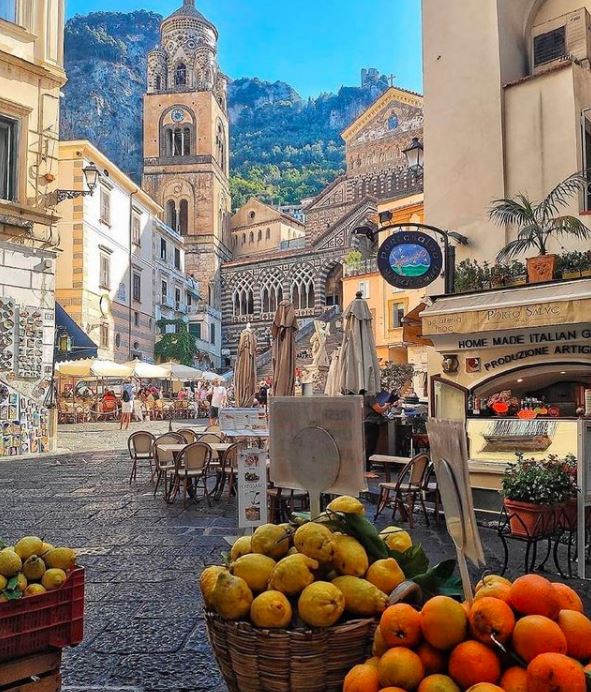
The magical Piazza Duomo in Amalfi
https://www.instagram.com/amalficoast_italy/
The heart of the coast, and a UNESCO World Heritage Site since 1997.
Amalfi dates back to the 4th century AD, when Roman refugees settled here. It reached its apex in 839 AD, when it declared its independence from the Byzantine Duchy of Naples, and became the first Maritime Republic in Italy. For centuries it was the only link between Europe and the whole of the Byzantine Levant. The first code of maritime laws, the Amalfian Laws, were compiled here, and remained in force until the 16th century. Amalfi also pioneered the use of the compass, and circulated its own currency, the "tarì". Amalfi's unique charm has always attracted artists, writers, painters, directors, and even one of the twelve apostles, saint Andrew, who has a 10th century cathedral dedicated to his honour, where his relics are housed in the crypt. Amalfi is enclosed by a natural amphitheatre where the Canneto river runs through the lush Valle Delle Mulini: water-powered paper mills transformed rags into precious paper. A 13th century paper mill now houses a fascinating paper museum.
Amalfi: it's located 16 km away from Positano
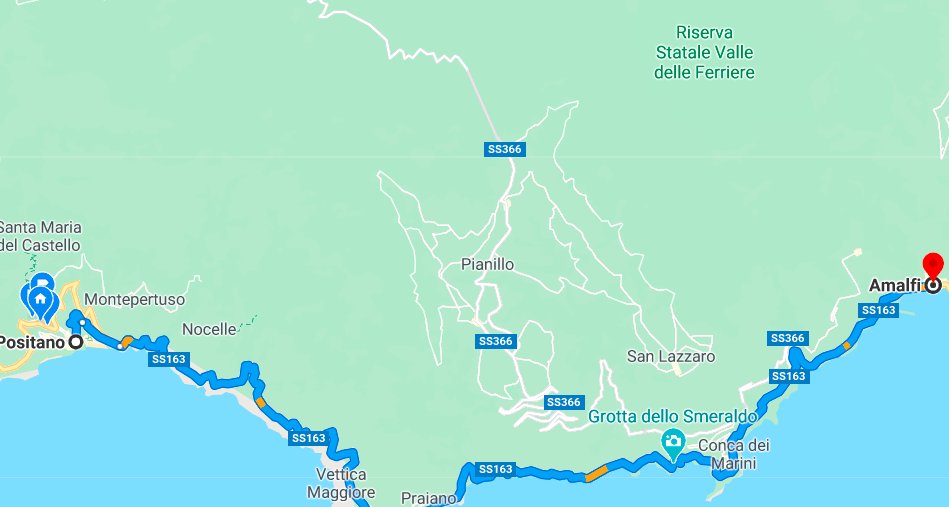
Parking in Amalfi and Atrani
The large Luna Rossa parking garage is set between these two towns, carved directly into the cliff face with a tunnel that leads to Amalfi on one side and Atrani on the other. It costs EUR 3/hour. In Atrani, there is paid street parking near the beach (blue painted lines) for EUR 2.50/hour. In Amalfi, you can park inside the port area in Piazza Flavio Gioia for EUR 3/hour.
Orientation to AMALFI TOWN
Amalfi waterfront is the coast's biggest transport hub.The bus station ,ferry docks,and a parking lot(euro 5/hour,if the lot is full, park in the huge Lunarossa garage ,burrowed into the hillside just past town,before Atrani) are next to each to each other.They are overlooked by a statue of local boy Flavio Gioia,the purported inventor of the mgnetic compass.Amalfi's TI is just up the main road,right before th post office and overlooking the beach..Before you enter the town,notice the colorful tile above the Porta della Marina gateway,showing off the trading domain of the maritime republic of Amalfi.Just to the left ,along the busy road,is a series of arches that indicate the long,narrow,vaulted halls of its arsenal -where ships were built in the 11th century.One of these is now the fine little Arsenal Museum.
Venture into the town and you'll quickly come to Piazza Duomo,the main square ,sporting a spring water-spewing statue of St.Andrew,and the Cathedral -the town's most nimportant sight.The farther you get away from the water,the more traditional Amalfi becomes.The Paper Museum is a 10 -minutes walk up Via Lorenzo d'Amalfi,the main drag .From here ,the road narrows and you can turn off onto a path leading to the shaded Valle dei Mulini;it's full of paper -mill ruins that recall this once proud ans prosperous industry.The ruined castle clinging to the rocky ridge above Amalfi is Torre dello Ziro,a good lookout point for intrepid hikers.
TOURIST INFORMATION
The TI is about 100 yards from the bus station , and ferry dock,next to the post office;facing the seahe ,it's to the left ( Mon-Fri.9:00-13:00 & 14:30 -17:30,Sat 9:00 -13:00,closed Sun,shorter hours off-season,pay WC in same courtyard,Corso della Repubbliche Marinare27,tel +39 089 871 107
http://www.amalfitouristoffice.it/
HELPFUL HINTS
Don't Get stranded: Be warned -the last bus back to Positano or Sorrento leaves as early as 20:00 ( in Oct-March,but likely ,somewhat later in other months:June -July at 22:00.Aug at 23:00,April -May and Sept at 21:00 -confirm times locallly ).Especially in summer,that last bus out may be full,leaving your only option a euro 100 taxi ride
BAGGAGE STORAGE
you can store your bags safely for euro 5 at the Divina Costiera Travel Office facing the waterfront square,across from the bus parking area ( daily 8:00 -13:00 & 14:00 -19:00,closed mid-Nov -March.tel.+39 089 872 467).
EATING IN AMALFI TOWN
Grabbing a Quick Lunch :To grab a fast bite,walk five minutes up the main drag;on the right,past the first archway,is Pizza Express,with honest Euro 4-6 pies,calzones,and heated sandwiches to go (Mond-Sat 9:00 -21:00,closed Sun,Via Capuano 46 ).The Cuoppo Amalfi fried -fish stand a Piazza dei Doge ( described below)is another good option;there is also a small supermarket facing the piazza ,and another supermarket( Deco')is just off of the main drag ( up an alleyto the right near # 34,at Via Dei Curiali ).Both supermarkets close for a midafternoon break and all day Sunday. Cornetti from euro 1,pastriesfrom euro 4,50;7:30 am -11 pm,closed early Jan -early Feb.A ;freshlymarbled and mirrored 1830 cafe on Piazza del Duomo where black -bow -tied waiters serve a great Italian breakfast;freshly made cornetti ( croisssants ) ,full boided espresso and deliciously frorhy cappuccino.Sandout pastries include the crisp,flakycoda di aragosta con crema di limone ,a lobster tall shaped concoction filled with a rich yet light lemoin custard creme
https://www.pasticceriapansa.it/
Amalfi: Where to Dine on a Budget
If you are staying in Amalfi for your holiday or visiting for the day, here is where you can eat well but inexpensively.Da Maria: Restaurant and Pizzeria
This is one of the most beloved pizzerias in Amalfi, located just a few steps from the Duomo. Here you can try traditional classics prepared with simplicity and passion. The restaurant has been run by the Pisacane family since 1968, and is a favorite with visitors and locals for its fresh fish and fantastic pizza.Our suggestions: spaghetti with clams and anchovies.Prices: from EUR 12 to 20.Via Lorenzo D'Amalfi, 14, 84011 Amalfi 089 871880
http://www.amalfitrattoriadamaria.com/
Cuoppo d’Amalfi: Fresh Fried Fish and Seafood
If you want an unforgettable snack in Amalfi without breaking the bank, stop at Al Cuoppo, a tiny spot located in a historic church tucked in the town's tiny backstreets. Open 24 hours a day, this street food mecca serves paper cones of fried fish and seafood that is always fresh. There are places to sit and eat outside, but there is always a crowd so it's best to place your order to go and enjoy munching on the crispy battered fish and seafood while walking through town.Our suggestions: there are a number of cone options, from calamari and shrimp, mixed fish and seafood, and even vegetables.
Prices: from EUR 5 to 12.Via Supportico dei Ferrari, 12
https://www.facebook.com/cuoppo.damalfi/
Pasticceria Da Leone
Need to satisfy your sweet tooth in Amalfi? Stop at the Pasticceria Leone in the center of town, a small bakery and pastry shop that would be easy to miss if not for the beautiful cakes in the window and aroma of coffee.Our suggestions: torta caprese, pastries, granita.Prices: from EUR 2 to 7.
http://www.pasticcerialeone.it/
Near tha Main Square,on PIAZZA DEI DOGE
If you want walk straight ahead from the cathedral stairs,go up the little covered lane,and hook right at the fork,you'll pop out in atmospheric little Piazza dei Doge.Slightly less trampled and more neighborhood-feeling than Piazza Duomo,this has several decent ( if forgettable)restaurants aimed squarely at pleasing tourists. The Cuoppo d'Amalfi fried-fish shop.on the right as your enter the square ,fills cardboard cones with all manner of deep-fried sea life..Bar la Piazzetta has good prices at its tables right in the middle of the square.And tucked at the corner of the square leading to the port ,la Taverna di Masaniello is a bit pricier,with good food
HIKES
Amalfi is the starting point for several fine hikes,two of which l've described here.The TI hands out photocopies of Giovanni Visetti'strailk maps or you can download them yourself at,
http://www.giovis.com
If you can find it,the best book on hiking is Julian Tippett's Sorrento Amalfi Capri Car Tours and Walks,wich useful color-coded maps and info on pubblic transportation to the trailheads.Lucia Ferrara a great guide based in Positano,leads hikesaround Amalfi.
Hike # 1:Pontone
This loop trail leads up the valley past paper -mill ruins,ending in the tiny town of Pontone;you can lunch there,and headback down to the town of Amalfi ( allow 3 hours total).Bring a good map,since it's easy to veer off the main route .Start your hike by following the main road ( Via Lorenzo d'Amalfi)away from the sea.After the Paper Museum jog right,then left to join the trail,wich runs through the shaded woods along a babbling stream.Heed the signs that warn people to stay away from the ruins of paper mills ( no matter how tempting they look),since many are ready to collapse on unwary hikers.Continue up to Pontone,where Trattoria l'Antico Borgo offers wonderful cuisine and great view( Via Noce 4,tel.+39 089 871 469).After lunch,return to Amalfi via a steep stairway.If you're feeling ambitious,before you head back to Amalfi,add a one -hour detour ( 30 minutes each way) to visit the ridgehugging Torre dello Ziro(ask a local how to find the trail to this tower).You'll be rewardedwith a spectacular view.
HIKE # 2:ATRANI
For an easier stroll,head to the nnearby town of Atrani.This village,just a 15-minute stroll beyond Amalfi town,is a world apart;its 1,500 residents consider themselves definitely not from Amalfi.Leave Amalfi via the main road and stay on the water side until the promenade ends.Cross the street ,continue a few more yards,then go up the whitewashed staircase just past the pizzeria.From here,twist up trough old lanes to a paved route that takes you over the hill and drops you into Atrani in about 15 minutes.
With relatively few tourist,a delightful town square ,and a free,sandy beach (if you drive here ,pay for parking at harbor).
Atrani has none of Amalfi trendy resort feel.Piazza Umberto is the core of town,with cafes,restaurants,and littele grocery stores that can make sandwiches.A whitewashed staircase leads up to the serene and beautiful town church ( under the clock face ).
To save time and sweat on the return walk ,follow the promenade just above water level toward Amalfi.
Then walk up trought the restaurant terrace and find the big,long tunnel next to the parking garage -this will deposit you in the middle f Amalfi.From Atrani ,you could theoretically continue up to Ravello .But be warned.Unless you're part mountain goat,you'ii probably perfect catching the bus to Ravello from Amalfi town indstead.
Getting to Amalfi from Positano
I recommend to catch the sita bus just accross bar internazionale at zone chiesa nuova which drops you in Amalfi
Getting to Amalfi by ferry from Positano
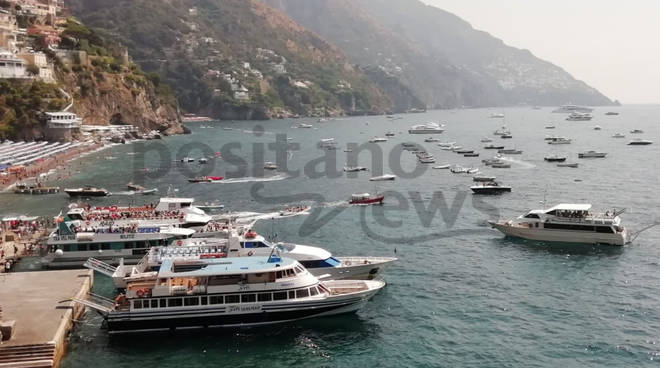
During the summer months, there are convenient sea crossings by ferry which depart Positano and stop in Amalfi
Getting to Amalfi by Car from Positano
If you're traveling by car, a piece of advice: be careful!
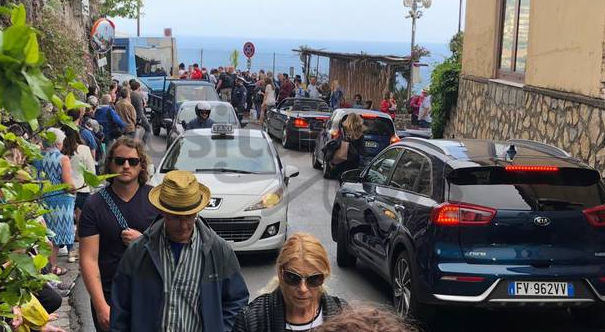
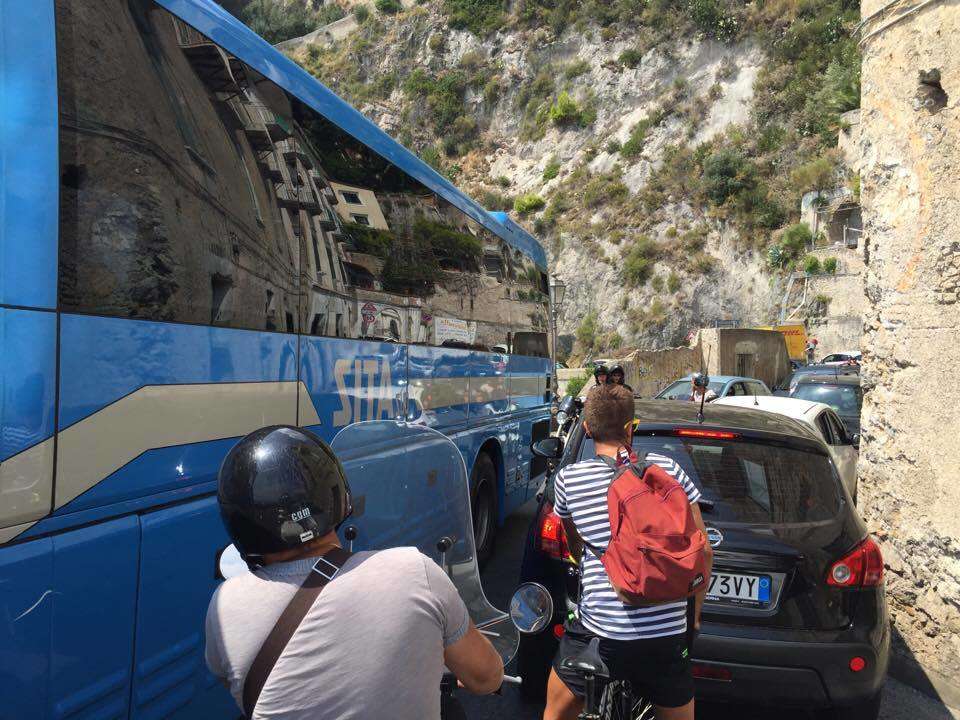
During the months of June ,July and August and on public holidays the road hugging the Amalfi Coast can be extremely busy and, as breathtaking as the scenery might be from your car window, spending hours stuck in a traffic jam under the Mediterranean sun is not much.
What to visit in Amalfi
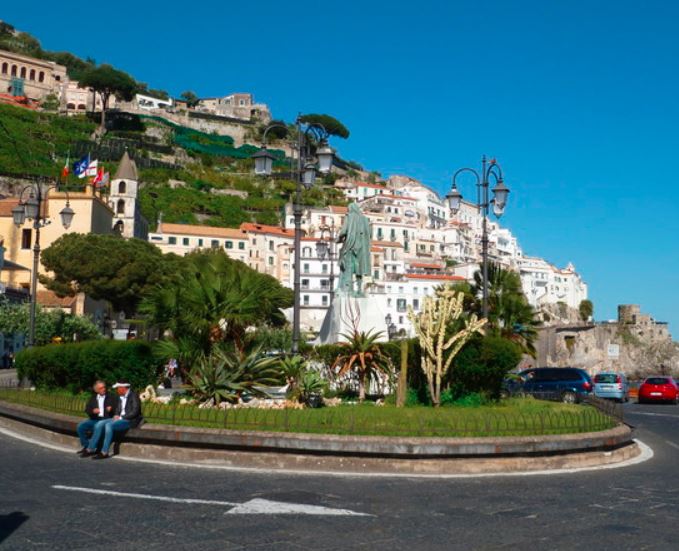
Piazza Flavio Gioia
Piazza Flavio Gioia is considered the entrance door of Amalfi, as it is the first that tourists encounter when arriving in the city. A short distance you reach the heart of the historic center in Piazza Duomo.
In the center of Piazza Flavio Gioia you can see the monument to the fellow citizen to whom it is dedicated, which according to tradition invented the compass in the fourteenth century giving a further boost to the seafaring power for which Amalfi was famous in medieval times. The statue is the work of Alfonso Balzico and is dated 1892. The Piazza is also the terminus of buses that arrive from the rest of Italy, while a few steps away you reach the port. Staying close to the coast, you can reach the interesting Museum of the Compass and the Duchy of the Sea, a few steps away, located in the ancient arsenal.
Address: Piazza Flavio Gioia
84011 - Amalfi (SA)
The Duomo of Amalfi
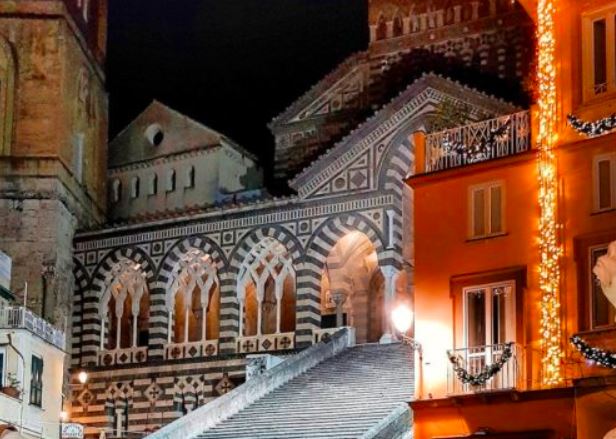
The Duomo of Amalfi: All You Have to Know About The Incredible Monument!
The Duomo of Amalfi is located right at the center of the town, a few meters far from Municipio Square. It’s one of the most important squares of the town and one of the most visited by tourists from all around the world.
Amalfi Cathedral is a 9th-century Roman Catholic structure in the Piazza del Duomo, Amalfi, Italy. It is dedicated to the Apostle Saint Andrew. Predominantly of Arab-Norman Romanesque architectural style, it has been remodeled several times, adding Romanesque, Byzantine, Gothic, and Baroque elements. The cathedral includes the adjoining 9th century Basilica of the Crucifix. Leading from the basilica are steps into the Crypt of St. Andrew.
The newer cathedral was built next to the older basilica that was built on the ruins of a previous temple. The remains of St. Andrew were reportedly brought to Amalfi from Constantinople in 1206 during the Fourth Crusade by Cardinal Peter of Capua. In 1208, the crypt was completed and the relics were turned over to the church. It said that later on Manna issued from the saint's bones.
Interior of Amalfi Cathedral
A wooden 13th century Crucifix hangs in the liturgical area. Another crucifix, made of mother-of-pearl, was brought from the Holy Land and is located to the right of the back door. The High Altar in the central nave is formed from the sarcophagus of the Archbishop Pietro Capuano (died in 1214). Above the altar is a painting by Andrea dell'Asta of The Martyrdom of St. Andrew. The boxed ceiling dates to 1702 and its artwork includes the Flagellation, the Crucifixion of the Apostle, and the Dell'Asta's 1710 Miracle of the Manna. The triumphal arch is held up by two Egyptian granite columns. There are two additional twisted columns and two pulpits that were part of the 12th century ambo. One of the pillars boasts a hidden column as an example of the ancient Romanesque structure.
Exterior of Amalfi Cathedral
The front facade was rebuilt in 1891 after the original one collapsed. It is of striped marble and stone with open arches that have lace detailing not commonly found in Italian sacred architecture while the tiled cupola is quite common amongst churches of the area. The tympanum's mosaics portray “The triumph of Christ” in a work created by Domenico Morelli and whose original designs are retained in the Town Hall.
Sixty-two steps, wide and steep, lead up to the doors. Cast in Constantinople before 1066, and signed by Simeon of Syria, the cathedral's bronze doors are the earliest in Italy of post-Roman manufacture. Begun in 1180, and completed over 100 years later, the Romanesque style bell tower is off-center. The structure includes four small towers of Arab architectural type that are adorned with arches and are covered with majolica tiles. During times of war, the bell tower was purposed for defense.
The garden contains colonnades, arches and sculptures.
http://www.amalfitouristoffice.it/
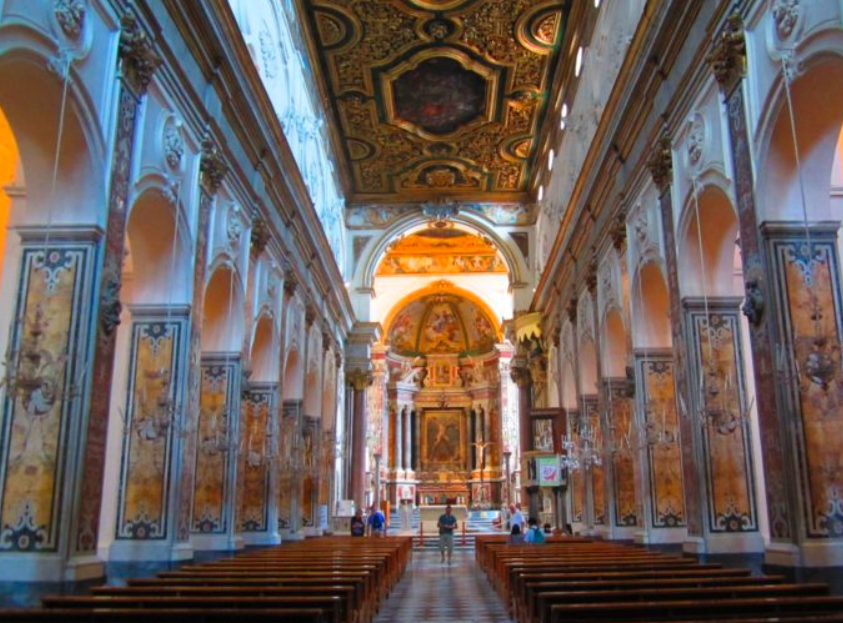
Opening Hours
Daily from March to June 9:00 - 18:45
Daily from July to September 9:00 - 19:45
Daily from November to February 10:00 - 13.00 & 14:30 - 16:30
NOTE: Free admission to the Cathdral during religious functions.
Il Chiostro del Paradiso – Heaven’s Cloister
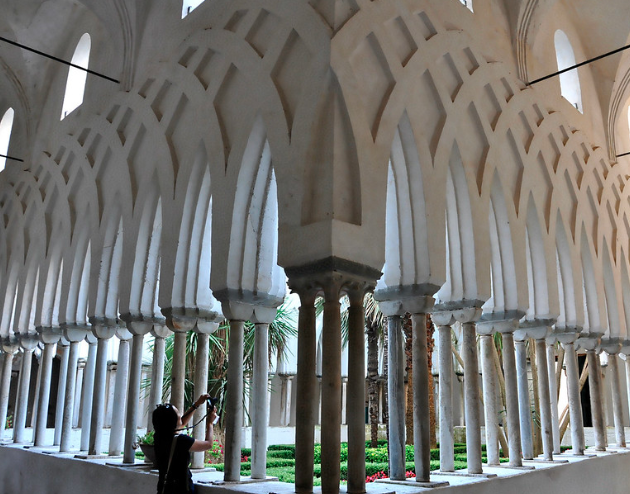
Il Chiostro del Paradiso – Heaven’s Cloister
It is the ancient cemetery of the nobles of Amalfi which was built between 1266 and 1268.
Art with its beauty makes us feel closer to God.
Here we enjoy the charm of these unmistakable intertwined arches, supported by 120 slender columns, with a strong oriental flavor.
Along the left gallery of the cloister, a white peristyle from whose arches leaks into the greenery of the small Mediterranean garden, various sarcophagi are exposed, among which those representing the Rape of Proserpina and the Union of Mars with Rea Silvia of the second half stand out 2nd century AD C.
On the same side you can admire the marble fragments with mosaic decorations of the ancient ambos of the cathedral, commissioned by Archbishop Dionisio (1174-1202) and made by artists active in Amalfi itself.
Continuing the visit, we can stop for a moment in the center of its north side to resume a characteristic shot of the bell tower of the cathedral
(1180-1276) with the bell tower decorated with Moorish style polychrome majolica.
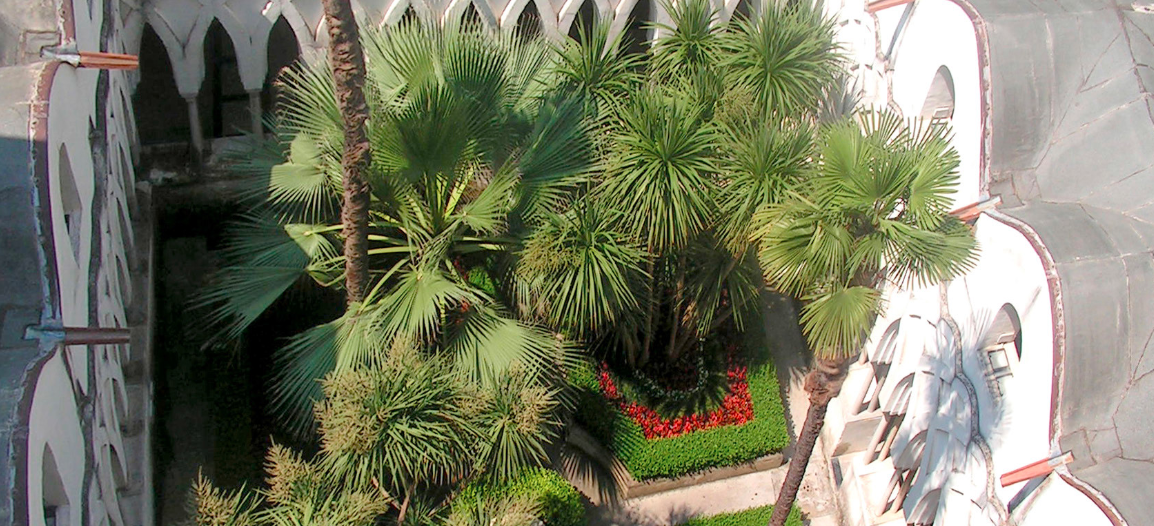
On the bottom are visible the funeral chapels of the cloister: of great interest is the one with the fresco of Christ Pantocrator of the second half of the thirteenth century and immediately after that with the Crucifixion attributed to Roberto d'Oderisio, the main painter active in Campania in the mid fourteenth century , who was an effective popularizer of the Giotto style.
Continue all the way to enter the basilica of the Crucifix passing through the noble chapel of the Corsanos with the interesting cycle of 14th century frescoes, unfortunately very deteriorated, attributed to the workshop of Cavallini, which includes the Dormitio Virginis and hosts of saints and prophets.
Opening time
Days Opening times
Every day from March to June 09h00 - 18h45
Every day from July to September 09h00 - 19h45
Every day from November to February 10h00 - 13h00 / 14h30 - 16h30
Phone+39 089.871324
Fax +39 089.871324
Price per person € 3.00
Price for children under 18 € 1.00
Price from 18 to 25 years € 3.00
Price for over 65 years € 3.00
Students (with list of names signed by the school) € 1.00
Group rate € 3.00
Week closing Always open
Closing during the year Always open
Note:The ticket includes a visit to the Cloister, Cathedral Museum, Crypt and Cathedral.
Since the Cathedral is closed to the public from 10h00 to 17h00; the only way to access it is through the Cloister and the Museum (paying the entrance ticket).
The Arsenal
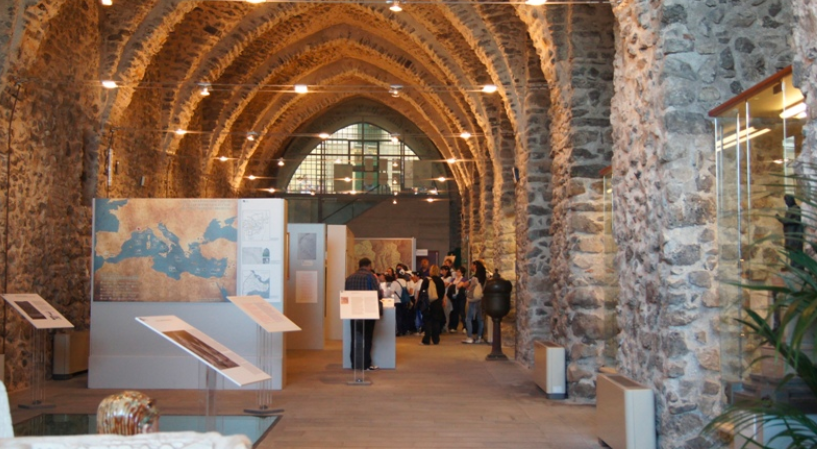
After walking through the rione Vagliendola, you will end up at the old Arsenal, the true hearth of the ancient Republic of Amalfi.
Rione Vagliendola
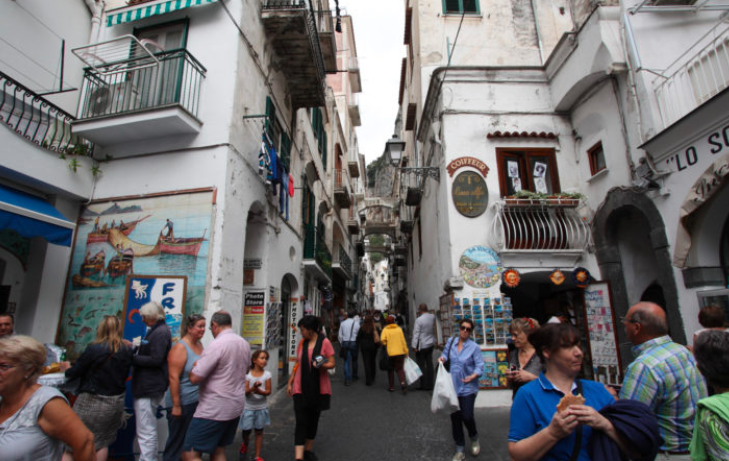
Rione Vagliendola is one of the oldest neighbourhoods of the town and one of the most famous among tourists.
You will be able to enjoy some of the true lifestyle of Amalfi: alleys, little shops, traditional trades and crafts: if you are looking for the truest heart of the town, Rione Vagliendola should definitely be on your to-see list.
Emerald Grotto: between Amalfi and Conca dei Marini
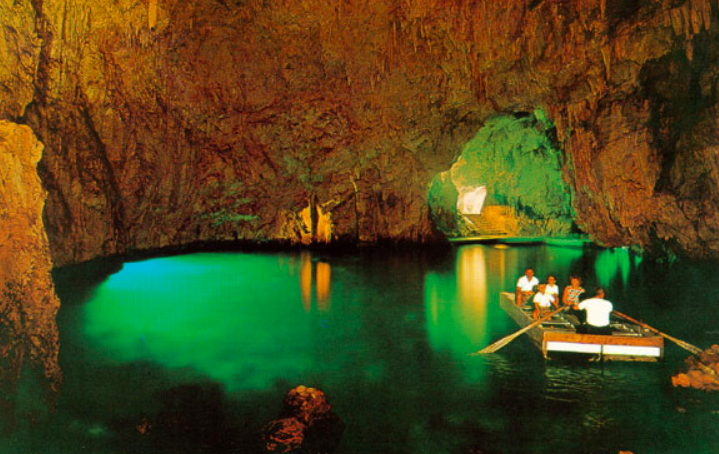
The Grotta of Smeraldo known as well with the name of "Emerald Cave" was named after the characteristic green light inside the cave. It is caused by natural sunlight from outside which enters the cave through an underground passage, which connects the salt water lake in the huge chamber with the sea outside. The water filters the sunlight and only green wave lengths reach the cave. It's really weird that the light is green while mostly the water becomes blue as for the nearby Grotta Azzura (Blue Grotto) on Capri. We suppose it is the orientation of the cave, the cave is located at the southern coast of the peninsula Amalfi coast.
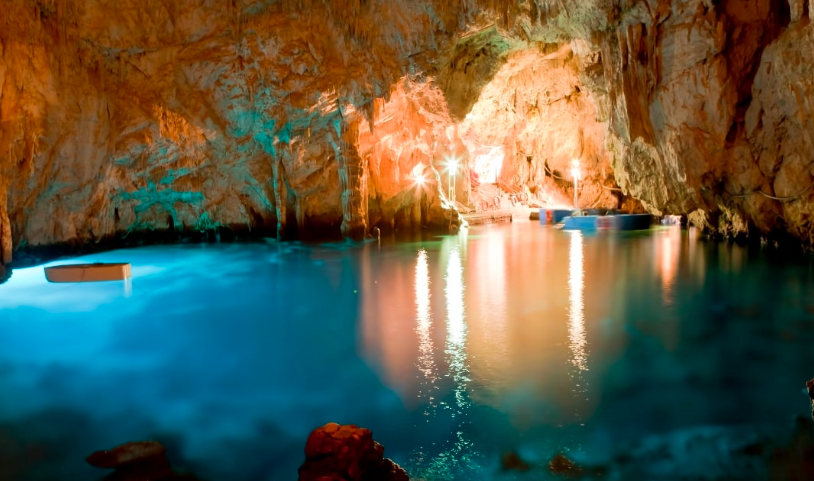
In order to reach the grotto there is a small parking along the coast road, a wide staircase going down to the sea and furthermore there is also an elevator. After paying the ticket of 5€, visitors enter the cave through an artificial tunnel. Inside there is a jetty with numerous wooden boats. The boat ride is the actual tour, so after a short look around you may enter the next boat and enjoy the calm gliding of the motorless boat.
The cave consists only of a single huge chamber. The lake inside is 45m by 32m big and the chamber is 24m high, above the sea level. There are some speleothems, as this is actually a karst cave. The cave was formed above the sea level, at a time when the sea was much deeper. Later the sea rose and flooded the entrance, or better the land went down, which is caused by the volcanic activities in the area. Some stalagmites on the floor were flooded.
The tour is not very expensive but the cave is very small and the whole visit takes only half an hour including stairs, cave, and boat ride. It is also essential to visit it at the right time. August is generally bad, because of the huge number of visitors, and we guess it's annoying to wait a long time for a rather abbreviated tour.
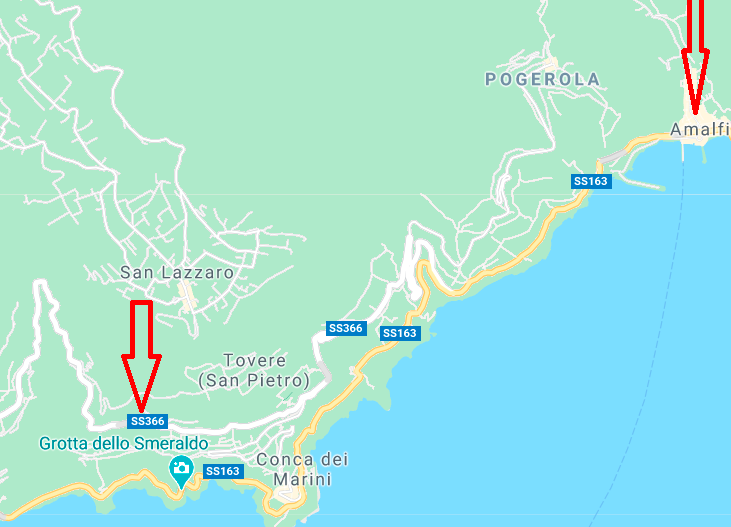
Opening Hours
MONDAY 9:00 - 16:00
TUESDAY 9:00 - 16:00
WEDNESDAY 9:00 - 16:00
THURSDAY 9:00 - 16:00
FRIDAY 9:00 - 16:00
SATURDAY 9:00 - 16:00
SUNDAY 9:00 - 16:00
Phone
+39 089.871107
Prezzo per persona € 6,00
Prezzo per i minori di 12 anni Gratuito
Prezzo per i minori di 18 anni € 5,00
Prezzo dai 18 ai 25 anni € 5,00
NOTE: From the middle of October to early April the working hours are from 9:00 to 15:00. Closed under adverse weather conditions
Amalfi Paper Museum
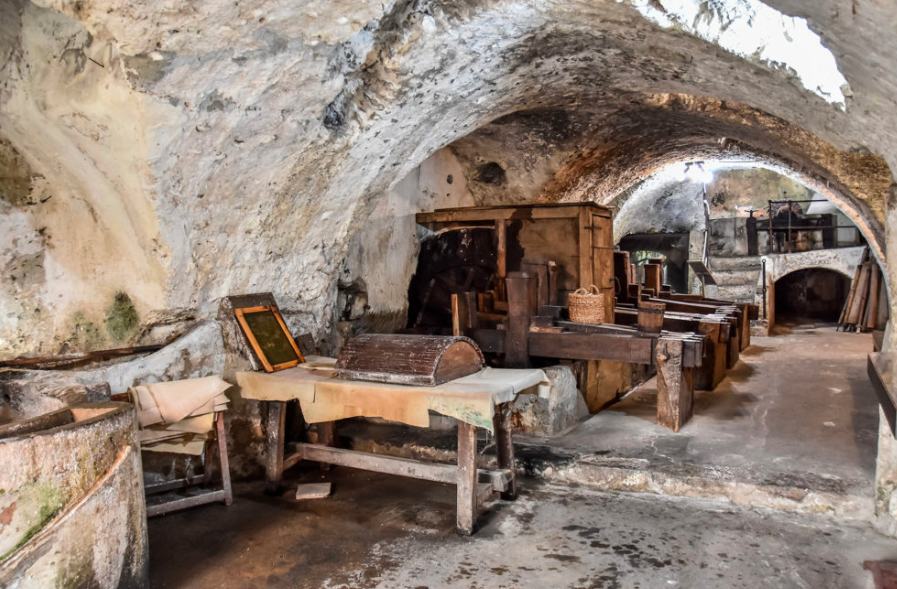
Among the first towns where it was discovered in the twelfth and thirteenth centuries the existence of the paper, if you want to take for granted the information contained in notarial deeds discussing of the existence of paper products, while not specifying whether these were imported from other places and traded in the above mentioned places, there were the territories of the Maritime Republics: Amalfi, Pisa, Genoa and Venice who had warehouses both in Syria, both on the coast of Palestine, where they were precisely located the major centers for the production of paper.
These republics also had intense trade relations with the East and they could learn from the Eastern art of making paper without too much difficulty, or it is possible that on board the galleys, which in medieval times shuttled between our coasts and the Holy Land to transport crusaders and merchandises, they are embarked "Magisters in art cartarum" which as skilled labor have introduced this type of work.
Amalfi is the oldest of the Maritime Republics, as early as the ninth century had its warehouses in Palermo and Messina and Syracuse, where the Amalfitana is still present in local place names. Age-old remains the question on the primacy of paper in Italy and then in Europe and in contention are mainly Amalfi and Fabriano.
The "Foundation Paper Museum" has always worked to spread, disclose and document what concerns the art of making handmade paper of Amalfi. All this is possible thanks to the work of its founder: Nicola Milano. He was forced to close the paper mill because it was impossible to continue to support the high costs resulting mainly from the lack of transport to link road. The last was closed in 1969 and was donated to the nascent Foundation, which he strongly desired and commissioned in November 1971, which was supposed to manage the big idea: the "Paper Museum".
Idea that through many problems and vicissitudes came today to be a concrete and interesting reality aimed at preservation of historical heritage and the recovery of ancient arts such as the manufacture of handmade paper.
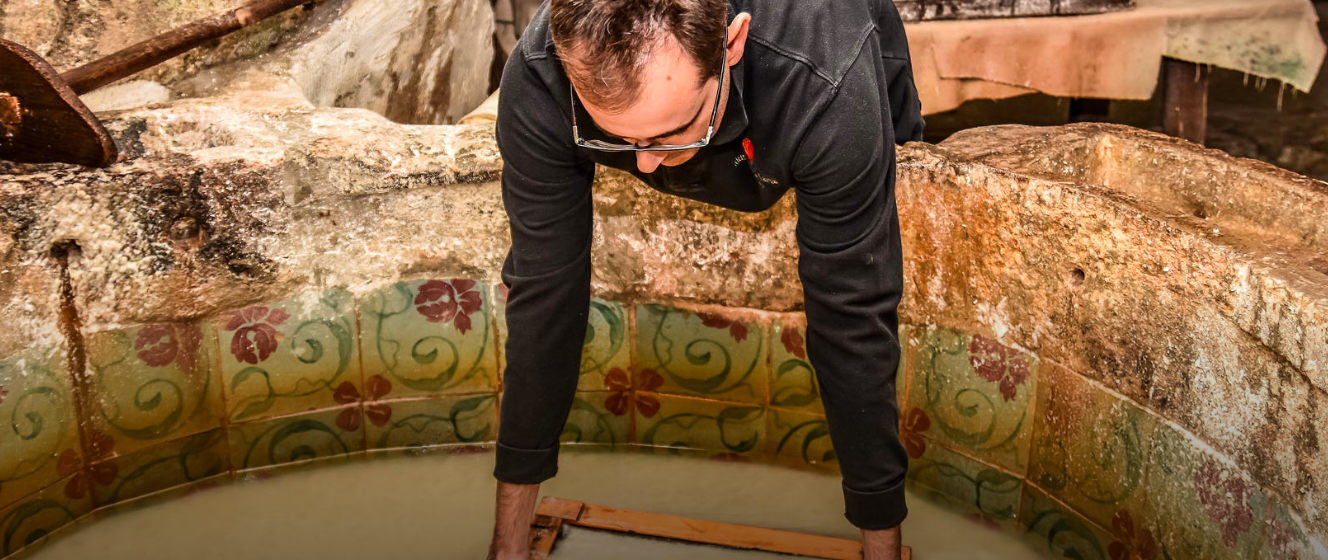
contacts
Via delle Cartiere, 23
84011 Amalfi (Sa)
+39 0898304561
Fax +39 089.872235
https://www.museodellacarta.it/
Price per person € 4.50
Price for children under 18 € 2.50
Price from 18 to 25 years € 4.50
Price for over 65 years € 4.50
Students € 2.50
Group rate (minimum 25 paying) € 3.50
Week closing
November - December and January - closed on Mondays
Closing during the year
24.12 - 25.12 - 26.12
Director of the museum Avv. Emilio De Simone
Opening time
From 1/3 to 31/10
the museum is open from 10.00 to 18.30
open all day - every day, Sunday included
From 01/11 to 31/01
the museum is open from 10.00 to 16.00
open all day - closed on Mondays
From 27/12 to 06/01
the museum is open from 10.00 to 18.30
open all day - every day, Sunday included
In the days 24-25-26 December
the museum will be closed for holidays
In the month of February
the museum will be closed for maintenance and preparation
Sant'Andrea Fountain:
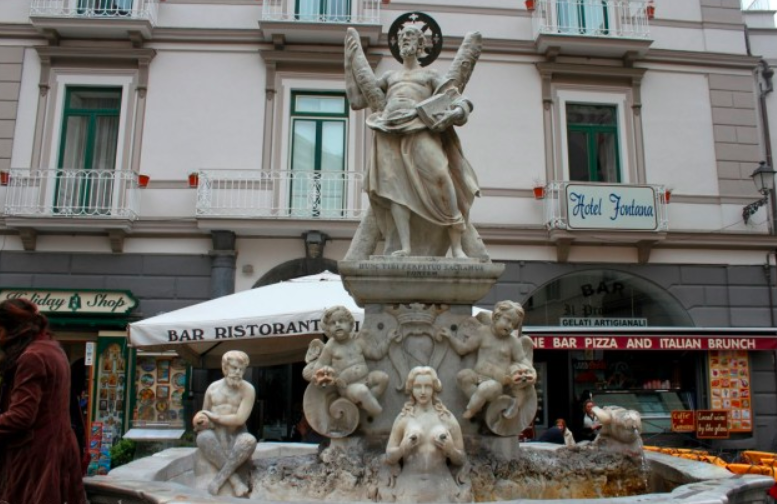
In Baroque style, it was built in 1760 and adorned with particular figures.
The alleys:
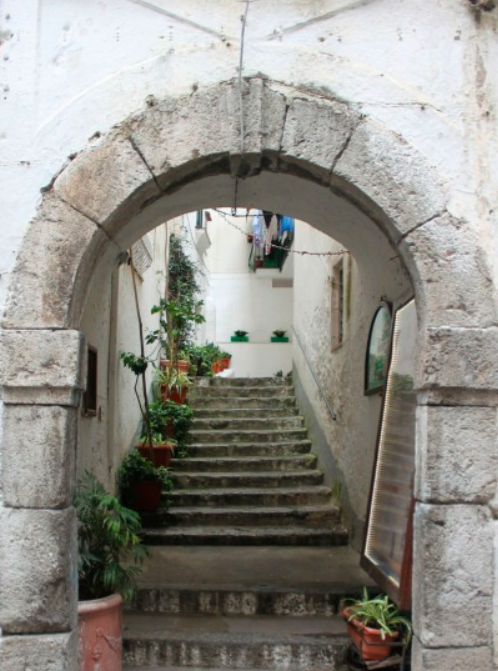
In Amalfi you will have to walk slowly, browse through one shop and the other and capture the details.
Due to the Covid-19 emergency, many routes have been suspended until 4 May, 2020.
« Read other articles